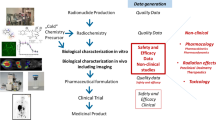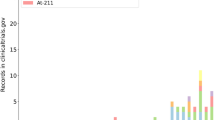Abstract
Introduction
To obtain the pharmacokinetic properties of drug candidates at an early stage of the development process, a microdosing (phase 0) concept to radiolabel drug candidates and administer them at subtoxic mass to a few volunteers has been suggested. Radiopharmaceuticals are special in the sense that the chemical carrier might be genotoxic, whereas it is well established that ionizing radiation coupled to the molecule is genotoxic, and that the mechanism that causes cancer is similar to certain genotoxic chemicals.
Regulatory perspectives of the levels of toxicity
An analysis shows that, e.g., positron emission tomography (PET) pharmaceuticals carry a mass less than what is regarded as an acceptable level of a genotoxic impurity. It has also been shown that the estimated genotoxicity hazard of the radioactivity is 10–100 times higher than that of the administered chemicals.
Conclusion
As radiation doses at this level are accepted in clinical trials, the conclusion is that the regulatory demands on radiopharmaceuticals produced at high specific radioactivity should be reconsidered in order to facilitate the use of the microdosing concept for drug development.
Similar content being viewed by others
References
Bergström M, Grahnén A, Långström B (2003) Positron emission tomography microdosing: a new concept with application in tracer and early clinical drug development. Eur J Clin Pharmacol 59:357–366
EMEA (2004) Position Paper on non-clinical safety studies to support clinical trials with a single microdose. CPMP/swp/2599/02/Rev1
FDA. Guidance for industry, investigators, and reviewers exploratory IND studies. http://www.fda.gov/cder/guidance/index.htm
National Council of Radiation Protection (NCRP) (2001) Report no. 136 Evaluation of the linear-nonthreshold dose-response model for ionizing radiation
International Commission on Radiological Protection (ICRP) (2005) Committee 1 task group report: C1 foundation document (FD-C-1). Biological and epidemiological information on health risks attributable to ionising radiation: a summary of judgments for the purposes of radiological protection of humans. Draft 21 April 2005
Scientific and Organizing Committee (1991) Overview, early indicators of non-genotoxic carcinogenesis. Mutat Res 248:213
Gold LS, Slone TH, Ames BN (1998) What do animal cancer tests tell us about human cancer risk. Overview of analyses of the carcinogenic potency database. Drug Metab Rev 30(2):359–404
Tran NL, Locke PA, Burke TA (2000) Chemical and radiation environmental risk management: differences, commonalities, and challenges. Risk Anal 20(2):163–172
European Medicines Agency (2004) Guideline on the limits of genotoxic impurities. . CPMP/SWP/5199/02
Muller L, Mauthe RJ, Riley CM, Andino MM, Antonis DD, Beels C, DeGeorge J, De Knaep AG, Ellison D, Fagerland JA, Frank R, Fritschel B, Galloway S, Harpur E, Humfrey CD, Jacks AS, Jagota N, Mackinnon J, Mohan G, Ness DK, O’Donovan MR, Smith MD, Vudathala G, Yotti L (2006) A rationale for determining, testing, and controlling specific impurities in pharmaceuticals that possess potential for genotoxicity. Regul Toxicol Pharmacol 44(3):198–211
Kroes R, Kleiner J, Renwick A (2005) The threshold of toxicological concern concept in risk management. Toxicol Sci 86:226–230
Kihlberg T, Karimi F, Långström B (2002) [11C]carbon monoxide in selenium-mediated synthesis of 11C-carbamoyl compounds. J Org Chem 67:3687–3692
Alauddin MM, Ghosh P, Gelovani JG (2006) Synthesis of [8F]-labeled N-3(substituted) thymidine analogues: N-3([18F]fluorobutyl)thymidine ([18F]-FBT) and N-3([18F]fluoropentyl) thymidine ([18F]-FPT) for PET. J Label Compd Radiopharm 49:1079–1088
Stålnacke CG, Sundell-Bergman S, Halldin C, Långström B (1985) Radiotoxicity of 11C-methionine of DNA strand break in mammalian cells. Eur J Nucl Med 11:166–170
Pouget JP, Mather SJ (2001) General aspects of the cellular response to low- and high-LET radiation. Eur J Nucl Med 28:541–561
Author information
Authors and Affiliations
Corresponding author
Rights and permissions
About this article
Cite this article
Lundqvist, H., Antoni, G. & Långström, B. Genotoxic hazard of radiopharmaceuticals in humans: chemical and radiation aspects coupled to microdosing. Eur J Clin Pharmacol 63, 641–645 (2007). https://doi.org/10.1007/s00228-007-0304-6
Received:
Accepted:
Published:
Issue Date:
DOI: https://doi.org/10.1007/s00228-007-0304-6




